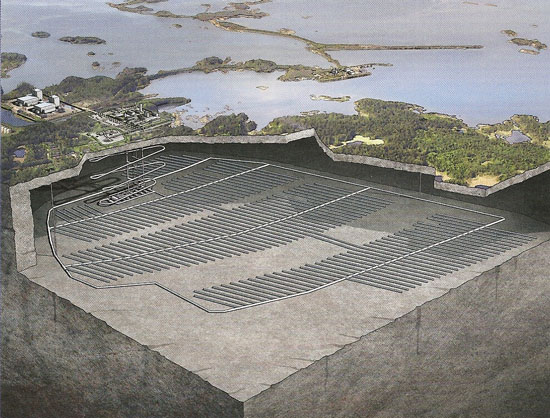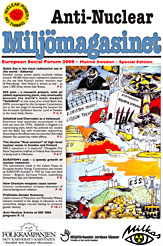Forsmark waste
Baltic Sea Regional ECRR admited to the Swedish Environmental court in Nacka comments on the outstanding information still to be answered by Swedish Radiation Safety Authority SSM and Swedish Nuclear Fuel and Waste Management Company SKB regarding (1) SKBs application to build the Forsmark Spent Nuclear Fuel Waste Final Repository and (2) its Environmental Impact Statement and associated data.
31.12.2013
ECRR objects to SKBs general rejection of commenting deeper on groups of questions included in the processes submitting most of radiation related issues to arbitration by SSM through Kärntekniklagen. All of this process should be brought before the Environmental Court as it primarily is an environmental issue.
SSM still has not asked SKB as an applicant to use a scientifically valid radiation risk model and has not started to engage independent experts.
ECRR identifies missing information still to be answered by SSM and SKB regarding SKB´s application to build Forsmark Spent Nuclear Fuel Waste Final Repository as well as its Environmental Impact Statement and associated data.
Summarising the current situation ECRR suggests the Court to rule the request for substantial source of funding for independent scientific scrutiny of the SKB application to build Forsmark Spent Nuclear Fuel Waste Final Repository (SNFWFR).
Comments PDF Nacka TR M 1333 11 aktbil 296
Appendix PDF with 3 earlier comments sent to authorities Nacka TR M 1333 11 aktbil 297
Court Schedule for Case M 1333-11 According to the Environmental Code, SKB’s application to build a final repository for spent nuclear fuel
http://nonuclear.se/files/m1333-11en/m1333-11aktbil17en.pdf
SKB´s application to build Forsmark Nuclear Waste Repository
All the application in Swedish and English: http://www.stralsakerhetsmyndigheten.se/Allmanhet/slutforvar/Ansokningarna/Ansokan-om-slutforvar/
Swedish Supreme Environmental Court judge speaks on preparations on the decision of EIS etc for the final nuclear waste repository in Forsmark
17-11-2010. The final decision over the utility and costs of the repository, it´s “BE or NOT TO BE” will be decided by the Miljööverdomstolen in Sweden (Swedish Supreme Environmental Court).
In Swedish: http://www.youtube.com/watch?v=v0v0LyTKC0k
The planned High Level Nuclear Waste Repository in Forsmark, Sweden
 The Low Level Waste Repository already operating at Forsmark
The Low Level Waste Repository already operating at Forsmark
The darker part in the drawing is the planned extention of the repository.
The Forsmark final repository
By Pr Nils-Axel Mörner
Forsmark in eastern middle Sweden has been chosen as the site for a final deposition of high-level nuclear waste according the KBS-3 method. SKB claims that they can guarantee a long-term safety of this repository for ”at least 100,000 years”. The background for this statement is based on an old concept of exceptional stability of the Fennoscandian bedrock, and multiple barriers in the repository; viz. the canisters, the filling of bentonite around them, the back-fill of shafts and excess tunnels and the bedrock itself.
The stability concept was – in the 1970s when the first decision about the method to use was taken – a reminiscence from an old paradigm held in the 1950s. Within the last 30 years there has been a complete paradigm change when it concerns the so-called stability of the Fennoscandian Shield. We now know (based on solid observational facts) that, during the phase of deglaciation with maximum rate of uplift, the earthquake activity was intensive both in magnitude (with events up to above 8 on the Richter-scale) and frequency (with 7 events recorded within 102 varve-years in the Stockholm region). The bedrock fractured over large distances (invalidating the safety distance used by SKB between regional fault and fracture zones and the proposed deposition of the canisters). A serious addition process recently documented at several sites is explosive methane venting at the transition from methane ice stored in bedrock voids to methane gas (at a volume ratio of 1:168). All these novel facts invalidate the claims of a full safety remaining over “at least 100,000 years”.
The Forsmark area does certainly not represent “the best area in Sweden” for a final KBS-3 repository. Geologically, it represents a major tectonic shear zone; i.e. an environment that one should rather avoid. The direct connection with the Baltic is another deeply negative factor (in anything goes wrong, a maximum spreading will occur via the Baltic). Therefore, a KBS-3 repository at Forsmark offers no trustworthy solution; rather the opposite.
Pr Nils-Axel Mörner
Forsmark – the town that wants nuclear waste
By Per Nyberg, CNN
CNN, April 25, 2011
with Video: http://edition.cnn.com/2011/WORLD/europe/04/24/sweden.nuclear.waste/
(CNN) — Like the energy source itself, it’s the question that won’t go away: what can be done with spent nuclear fuel?
Sweden believes it has the answer.
The plan is to bury the country’s expected 12,000 tons of nuclear waste in corrosion-resistant copper canisters under 500 meters of crystalline bedrock. There it will remain isolated from human contact for at least 100,000 years.
The idea, which still needs final approval, was developed by Swedish Nuclear Fuel and Waste Management company (SKB) — a collective of Sweden’s nuclear power companies.
After three decades of research, SKB believes that Osthammar in central Sweden is the perfect final resting place for the country’s nuclear waste. Not only is the 1.9 billion-year-old bedrock ideal says SKB, but the locals are largely in favor of the plan and it is close to the nuclear power plant at Forsmark.
Gallery: Sweden’s nuclear waste solution
I think the closer you live the less scared you are. The waste has to be stored somewhere, so why not here? -Erik Waernulf, Osthammar resident
I grew up not far from the Forsmark nuclear power plant. In school they took us on tours of the facility and many friends’ parents worked at the plant. The region also has a long history of mining and ironworks, so having the nuclear industry as neighbor was nothing strange.
My parents still live there, and recently my mother got a call from a researcher asking her what she thought of the planned repository.
“Do you trust the authorities to solve the problem today in your neighborhood, or do you want to wait for a better technology and leave the waste to future generations who did not actually benefit from the nuclear power?” she was asked.
The latest poll showed that 88% of Osthammar residents are in favor of having the storage site in their community.
Swedes have a complicated relationship to nuclear power. Following the Three Mile Island incident in the U.S. in 1979, Sweden voted to shut down all its nuclear reactors by 2010.
However the decision was overturned by a new government and only two reactors were decommissioned. Today Sweden’s 10 nuclear reactors produce almost half of the country’s electricity.
Nearly 90% of Osthammar residents are in favour of having the nuclear storage site.
Sweden has so far accumulated more than 5,000 tons of spent fuel. It is stored in a bright blue water tank, 40 meters underground in the southern city of Oskarshamn. But even though the radiation is shielded by eight meters of water, this facility has to be monitored 24 hours a day, every day of the year.
“And we will certainly not do that for the next 100,000 years,” Brita Freudenthal, SKB’s guide at the facility told me.
After a few mishaps in the early stages of looking for a community that would be willing to accept the final repository, SKB started visiting the locals in their homes to have a face-to-face dialogue over some coffee and biscuits.
“The women talk more about the water, if they can eat the berries in the forest, if they can eat the moose they hunt. Men are more interested in the technology, if the canister will be safe. If there is a question, I’ve heard it,” said Saida Laârouchi Engstrom from SKB.
Erik and Catharina Waernulf live in Forsmark with their four young children.
“SKB are very good at giving information” Catharina said.
“I think the closer you live the less scared you are. The waste has to be stored somewhere, so why not here?” Erik added.
For the mayor of Osthammar, Jacob Spangenberg, whether or not to accept the repository has nothing to do with the new investment and the new jobs it would generate.
“This is a possibility for our nation and our society to solve a very, very difficult problem,” he said.
The industry’s application is now undergoing a thorough review by the Swedish authorities. Mayor Spangenberg has the ultimate right of veto if he is not satisfied with the results.
There was another community, Oskarshamn, that also wanted the repository, but SKB’s geological surveys showed that the bedrock was much safer near Forsmark.
But if the application doesn’t go through, or Osthammar doesn’t accept the results of the review, what is Sweden going to do with the waste? It’s a tricky question that not only this Nordic country has to face.


